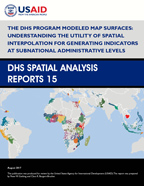- PUBLICATIONS
- JOURNAL ARTICLES
- ACCESS PUBLICATIONS
Publications Summary
- Document Type
- Spatial Analysis Reports
- Publication Topic(s)
- Geographic Information
- Language
- English
- Recommended Citation
- Gething, Peter W. and Clara R. Burgert-Brucker. 2017. The DHS Program Modeled Map Surfaces: Understanding the Utility of Spatial Interpolation for Generating Indicators at Subnational Administrative Levels. DHS Spatial Analysis Reports No. 15. Rockville, Maryland, USA: ICF.
- Download Citation
- RIS format / Text format / Endnote format
- Publication Date
- August 2017
- Publication ID
- SAR15
Download
 The DHS Program Modeled Map Surfaces: Understanding the Utility of Spatial Interpolation for Generating Indicators at Subnational Administrative Levels (PDF, 5194K)
The DHS Program Modeled Map Surfaces: Understanding the Utility of Spatial Interpolation for Generating Indicators at Subnational Administrative Levels (PDF, 5194K)
